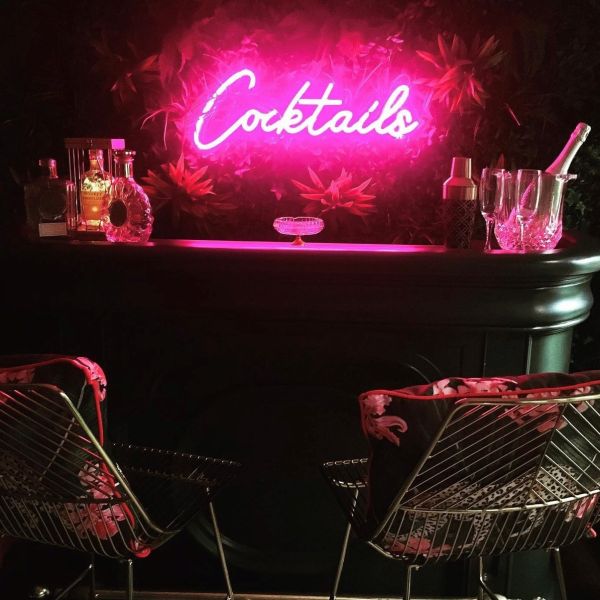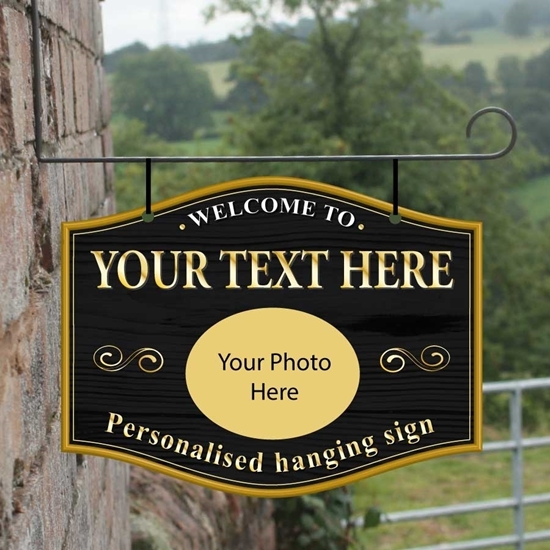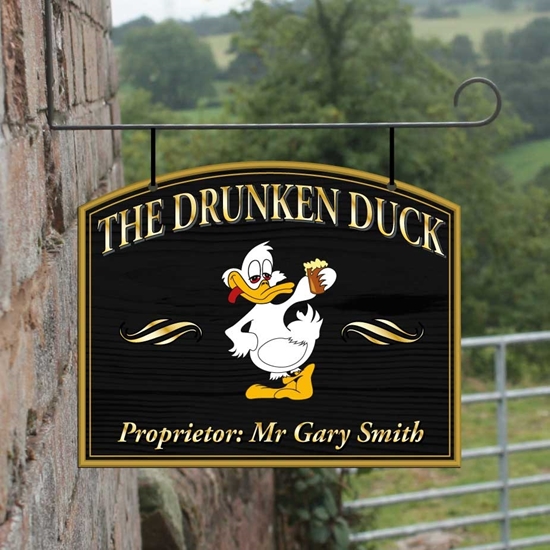The bar signs are different in their the purpose for which they are used. Signs for bars serve a variety of distinct functions. Branding
The purpose of this campaign is to establish and reinforce the brand's identity.
Often features the bar logo, name and distinctive colours. The bar's theme and vibe should be reflected in the design.
Customized metal signs bearing the name of the bar or a neon sign bearing its logo are examples.
2. Informational
The purpose is to inform customers on the bar.
Features: Simple-to-read, clear text that conveys essential information such as operating hours, Wi-Fi passwords and house rules.
Examples: Signs near the entrance indicating the hours of operation and signs that point towards restrooms.
3. Decorative
Objective: Enhance the aesthetic appeal of the bar.
Features: Usually more aesthetic or thematic, adding to the bar's overall decor. It is not allowed to include text or particular information.
Examples: Vintage ads for beer, signs with an edgy or funny theme and themed artwork.
4. Promo Coupons
Goal: To advertise products, events or specials.
Highlights: Catchy designs that highlight special offers and upcoming events or menu items that are new. It could include temporary or removable elements.
For instance, chalkboards that feature daily specials, banners promoting happy hour, or posters advertising events coming up.
5. Directional
The purpose of this sign is to guide patrons within the bar.
Features: Clear arrows to assist customers to follow, e.g. finding restrooms or exits, as well as other areas within the bar.
Examples: Signs pointing to restrooms, "Exit" signs, directions arrows to different seating areas.
6. Regulatory/Compliance
Objective: To comply with legal requirements and to make sure that you are safe.
Features: Signs that are essential to meet legal requirements such as smoking zones, occupancy limits or emergency exits.
Signs that prohibit smoking, limit occupancy or indicate emergency exits are examples.
7. Interactive
Goal: To connect with customers and provide an engaging experience.
Features: Element designed to encourage patron interaction including writing-on or interactive surfaces.
Signs with QR codes that provide links to menus in digital format, social media sites or other information sources.
8. Thematic
Goal: To create a certain theme or ambience.
The signs are designed to align with the theme of the bar contributing to the overall experience and atmosphere.
Examples: Pirate signs in nautical bars, rustic wooden signs at bars with a rustic theme.
9. Menu
Purpose: To show the bar's menu of food.
Features: A clear listing of food and drinks and beverages, often with price. It can be permanent or changeable.
Examples include: Digital screens that show the menus in rotation, or wall-mounted drinks menus.
Each type of bar sign serves a distinct purpose and is designed accordingly to perform its particular function within the bar. Understanding these differences will help bar owners decide on and put up signs that meet their requirements and enhance the experience patrons. View the best bar sign hanging recommendations for blog tips including pub wall sign, small pub signs, pub signs for home bars, the staying inn bar sign, novelty bar signs, personalised bar signs, pub sign hanging, personalised metal bar signs, bar signs for home, home bar pub signs and more.

How Do Bar Signs Differ In Terms Of Personalisation And Customisation?
The personalization and customization of bar signs is made to reflect the design the brand, atmosphere and style of a specific establishment. The following are the differences between bar signs in regards to personalization and customization: 1. Materials
Customizable Materials: Wood, metal neon, acrylic chalkboard, LED.
Personalization: Select materials that complement the style of your bar and the preferred style. For example rustic wood is a great choice for a warm bar. The sleek acrylic is ideal for a contemporary lounge.
2. The Design
Custom Graphics - Logos, illustrations and typography.
Personalization: Incorporate branding elements, distinctive images, or themes to convey the bar's personality and atmosphere.
3. Size and Shape
Custom Sizes: from small outdoor marquees to large tabletop signs.
Personalization: Adjust the size and shape to be suitable for specific locations, and satisfy branding requirements. For instance, large letters can be used to create a bold statement piece. Compact signs are perfect for small spaces.
4. Color
Custom color schemes for custom colors: Pantone matching and RGB options.
Personalization Select colors that match the bar's branding or the decor of the bar, or the target audience preferences.
5. Lighting
Custom Lighting Effects, including LED, neon backlit, edge-lit and projection.
Personalization: Choose lighting that will enhance visibility, ambiance and mood while also enhancing the overall look of the bar. For example, choose LED or neon lights for a modern feel.
6. Text and messaging
Custom Text: Bar name, slogans, quotes, menu items, event announcements.
Personalization: Create personalised messages that reflect the personality of your establishment while communicating promotions, deals, and brand values.
7. Interactivity
Custom Interactive Features such as QR Codes, digital displays, or interactive projections.
Personalization - Use interactive elements, such as menu boards or games to encourage and engage patrons.
8. Mounting and installation
Custom-designed mounting Wall-mounted (hanging) or freestanding (freestanding) or window-mounted.
Personalization: Choose mounting options that are compatible with the bar's layout, optimize visibility and seamlessly with the overall design, whether sleek and minimalistic or striking and eye-catching.
9. Seasonal and Event-Specific
Custom Themes: Holiday decorations, seasonal themes, or themed events.
Personalization - Refresh signs regularly to reflect seasonal changes. commemorate holidays, announce special events or make a lively and stimulating environment for patrons.
10. Brand Consistency
Custom Branding Custom Branding: Colors, fonts, images, logos.
Personalization: Ensure that every signage and branding material is consistent to help build brand recognition, strengthen the brand's image and create an experience that is consistent for customers.
The benefits of customization and Personalization
Brand Differentiation: Stand out from the crowd and create a lasting impression.
Brand Identity - Reaffirm the brand's identity and values to increase customer loyalty.
Atmosphere enhancement: Match the signage to your bar's environment and the desired atmosphere to enhance the experience for customers.
Engagement: Personalized signage can stimulate conversations, create excitement, and stimulate patron interaction.
With the help of customization and personalization features Bar owners can create unique, impactful signs that not only convey information but also enhance the aesthetics, atmosphere branding and overall appearance of their establishment. Follow the top rated his comment is here on gin bar sign for site advice including pub bar signs for sale, outdoor personalised bar sign, indoor bar signs, bar signs, personalised garden bar signs, hanging bar sign, staying inn sign, bar signs for garden, large pub sign, personalised cocktail sign and more.

What Are The Main Differences Between Bar Signposts And Regulations?
There are a variety of laws that govern bar signs. These include local, state and federal laws to ensure security for the public and aesthetic standards. The regulations for bar signs vary. Dimensions and Placement Regulations
Zoning Laws: Regulations specify the location of signs, their size, height and distance from property lines, roads or adjacent buildings.
Historic Districts: Signs may be limited to preserve the historical nature of certain districts. This may include restrictions on design, size and material.
2. Illumination Restrictions
Light Pollution: Regulations could restrict the brightness, color and duration of illuminated signs to minimize light pollution and protect the nighttime environment.
Safety considerations Signs should not produce glare and should not hinder drivers or pedestrians especially when they are located near the road.
3. Signage Content
Alcohol Advertising Certain jurisdictions have restrictions on alcohol advertising that prohibit certain types of images or content that could attract minors or encourage excessive drinking.
Health Warnings: Laws may require the display of health warnings regarding the dangers of drinking alcohol or smoking cigarettes.
4. Historic Preservation Regulations
Signs in historic areas must be compatible with the architectural style of the district. This is typically performed by preservation boards or commissions.
Material and Design: Signs that are historical in significance may be subject to restrictions regarding the materials used or the style and color scheme.
5. Sign Permitting Process
Permit requirements: Before installing or changing signs the bar owners have to get permits. This might require filing plans, paying for fees and obtaining approval from the local authorities.
Code compliance: Signs must comply with the construction codes as well as fire safety standards and accessibility guidelines to ensure public safety.
6. Sign Removal, Maintenance and Repair
Maintenance Requirements Owners of bars have to keep signs in good shape make sure they are structurally sound and free of dangers. They must also adhere to the laws.
Signs that are abandoned: Regulations could govern the removal of signs that are abandoned or damaged to prevent blight and maintain the beauty of the area.
7. Digital Signage Regulations
Content Restrictions. Laws may restrict what images can be displayed on digital signs. For instance they may prohibit flashing lights or images that are offensive.
Limitations on Operationality Regulations could limit the brightness of digital signs, frequency and motion to minimize visual obstructions.
8. Penalties and Enforcement
Inspections: Local authorities carry out periodic inspections in order to verify compliance with sign regulations. Citations are issued for violations.
Penalties - Penalties can include fines or court orders, requests for signs to be removed or modified as well as legal actions.
9. The Signing Variance Process
Bar owners can apply for Variances: Bar owners are able to request variances to depart from the regulations for signs that apply to all establishments. They must demonstrate they have a legitimate reason for the deviation and mitigate any negative impacts on safety or aesthetics.
Public Participation. The issue could require public hearings, and/or participation from members of the community. This may include neighbors, property owners, business associations, and/or residents of nearby communities.
10. Community Input and Engagement
Public Consultation - Some areas include community members in the design and implementation of signage regulations by holding public meetings or surveys.
Sign regulations could have community Benefits for Communities. Sign regulations could contain provisions that improve the appearance of signs, advertise local businesses, and help revive neighborhoods.
By adhering to the signs regulations, bar owners are able to ensure that the signs they put up enhance the visual attractiveness and worth of their establishment, as well as contribute to the community. They will also be legally compliant which lowers the possibility of penalties, fines or legal battles. Follow the best window vinyl for website examples including the staying inn pub sign, personalised bar signs, the pub sign, staying inn sign, novelty bar signs, design your own bar sign, pub signs to buy, personalised sign for bar, hanging pub signs personalised, indoor bar signs and more.
